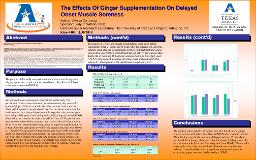
ATTENTION: The works hosted here are being migrated to a new repository that will consolidate resources, improve discoverability, and better show UTA's research impact on the global community. We will update authors as the migration progresses. Please see MavMatrix for more information.
Show simple item record
| dc.contributor.author | Contreraz, Alyssa | |
| dc.date.accessioned | 2019-04-09T23:51:22Z | |
| dc.date.available | 2019-04-09T23:51:22Z | |
| dc.date.issued | 2018-12 | |
| dc.identifier.uri | http://hdl.handle.net/10106/27941 | |
| dc.description | KINE 4400 | |
| dc.description.abstract | **Please note that the full text is embargoed** ABSTRACT: INTRODUCTION: Delayed onset muscle soreness (DOMS) peaks 24 to 48 hours after eccentric exercise. DOMS is characterized by increased pain, decreased range of motion, decreased strength, and inflammation to the working muscles. The most common ways this condition is treated is by the use of non-steroidal anti-inflammatory drugs (NSAIDS),cryotherapy, massage, and stretching. Ginger is known to have anti-inflammatory and analgesic properties. Ingestion of ginger may be used to decrease recovery time and to reduce the effects of DOMS and after eccentric exercise.
PURPOSE: The purpose of this study was to determine whether or not the use of ginger prior to exercise would reduce the effects of DOMS after eccentric exercise.
METHODS: Six untrained men (age 22.5 ± 2.07 yrs) volunteered to participate in this study. Each participant was assigned either 2,000 mg of ginger (GIN) or a placebo (PLA) to take one hour prior to exercise. Muscle soreness was induced by a heel raising exercise, the exercise was performed until the subjects reached fatigue. The variables measured in this study were the time the participant was able to perform the exercise, pain level using a 1-10 point visual analog scale (VAS), range of motion (ROM) of the ankle, and muscle circumference (MC) of the calf. The pain level, ROM, and muscle circumference were taken before, immediately after, 24-hours and 48-hours after the exercise test. After the subjects completed the measurements for their first treatment, they came in four days later for their second treatment. An activity log was recorded during the 24-hour and 48-hour post-exercise meetings. The alpha level for significance was set at p <0.05.
RESULTS: The exercise times obtained for both groups are as follows: PLA = 0.82 ± 0.64 min; GIN = 1.50 ± 1.37 min. The pre-exercise measurements were: VAS (GIN: 0 ± 0; PLA = 0.17 ± 0.41); MC (GIN: 41.5 ± 4.88 cm; PLA: 41.5 ± 4.42 cm); ROM (GIN: 39.3 ± 1.03° ; PLA: 39.2 ± 1.60°). The post exercise measurements were: VAS (GIN: 3.08 ± 1.86; PLA: 3 ± 1.90); MC (GIN: 42.4 ± 4.16 cm; PLA = 42.5 ± 4.67 cm); ROM (GIN: 39.5 ± 0.84°; PLA: 38.8 ± 1.60°). The 24-hour post-exercise measurements were: VAS (GIN: 1.5 ± 1.38; PLA: 1.5 ± 1.97); MC (GIN: 42.0 ± 4.46 cm; PLA: 41.8 ± 4.50 cm); ROM (GIN: 39.3 ± 1.03°; PLA: 39.7 ± 1.21°). The 48-hour post-exercise measurements were: VAS (GIN: 3 ± 3.46; PLA: 2.5 ± 2.43); MC (GIN: 41.7 ± 4.20 cm; PLA: 41.7 ± 4.66 cm); ROM (GIN: 38.5 ± 2.51°; PLA: 39.5 ± 1.97°). The measurements gathered in this study show that no statistical significance was present in the exercise times (p = .302), VAS (p = .970), MC (p = .886), and ROM (p = .281) between the PLA and GIN groups. It was also shown that there was no significant difference in VAS (p = .891), MC (p = .999), and ROM (p = 0.859) between the subjects after the heel raising exercise.
CONCLUSION: The results of this study do not support the claim that the use of ginger prior to exercise will reduce the effects of DOMS after eccentric exercise. These findings may be due to a lack of dosage and time. Previously, it was found that a dosage of 4 grams a day for a total of 5 days prior to the exercise resulted in reduced recoverytime from DOMS. | en_US |
| dc.description.sponsorship | Faculty Sponsor: Judy R. Wilson | en_US |
| dc.language.iso | en_US | en_US |
| dc.publisher | The University of Texas at Arlington | en_US |
| dc.subject | Ginger supplementation | en_US |
| dc.subject | Delayed onset muscle soreness | en_US |
| dc.title | The Effects of Ginger Supplementation on Delayed Onset Muscle Soreness | en_US |
| dc.type | Presentation | en_US |
| dc.publisher.department | Department of Kinesiology | |
Files in this item
- Name:
- Contreraz Poster Presentation - ...
- Size:
- 509.9Kb
- Format:
- PDF
- Description:
- PDF
This item appears in the following Collection(s)
Show simple item record


